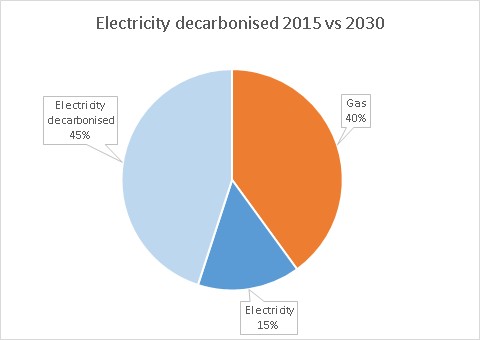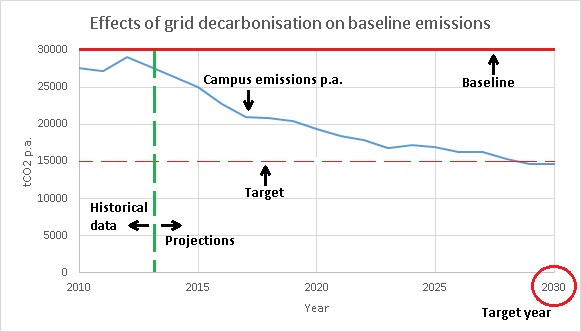Grid Decarbonisation
When considering investing in carbon abatement technologies it is worth considering how the carbon intensity of the grid will vary with time. This will have a significant effect on yearly emissions from electricity considering electricity contributes approximately 60% of carbon emissions every year to university campuses in the UK.
DECC (2015) predicts that the grid carbon intensity will drop from 422 gCO2/kWh in 2015 to 103 gCO2/kWh in 2030. By quartering the grid carbon intensity, the emissions from electricity effectively quarter as well. This will come close to achieving a 50% reduction in emissions from 2015 to 2030, as demonstrated by Figure a.

Strathclyde and grid decarbonisation
As Strathclyde has a slightly higher proportion of electricity consumption compared to the national average (72% carbon contribution compared to approximately 60% nationally, see link), the decarbonisation of the grid will contribute more than average to reduction in baseline emissions. In fact, with a business as usual approach (i.e. zero investment into carbon reduction strategies) the university would meet its target for 50% CO2 reductions by 2030 according to DECC projections (Figure b).

Key points
It is important to note that while DECC is a reputable source, projections of grid carbon intensities are just that: projections. Universities, as public bodies, have a legal obligation to meet Scottish national targets (see policy page). It is inadvisable to rely solely on projected grid decarbonisation in order to meet these targets.
Another key point is that by investing in energy and carbon reduction measures early, targets post 2030 will be easier to meet. It is essential to invest in more financially attractive measures alongside the high capital cost, low return projects. This is particularly important in the cases of heating and fabric upgrades which could be bundled with lighting and PC upgrades. Cross subsidising in this way will help lay the groundwork early on for the 80% CO2 reduction by 2050 without the need for large injections of capital in a relatively short period of time post 2030.
References
DECC (2015) 2015 Government GHG Conversion Factors for Company Reporting:Methodology Paper for Emission Factors Final Report [pdf] Available at: http://www.ukconversionfactorscarbonsmart.co.uk/Documents/Emission%20Factor%20Methodology%20Paper%20-%202015.pdf (Accessed: 30 April 2016)